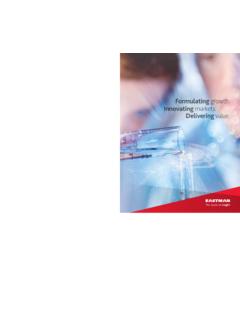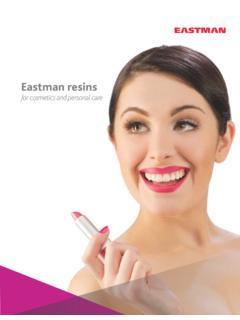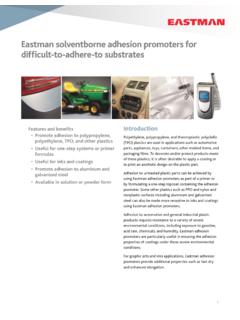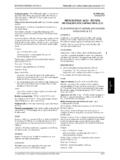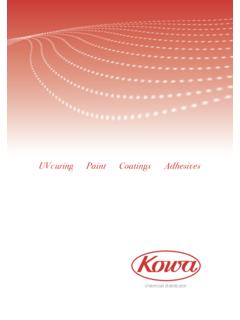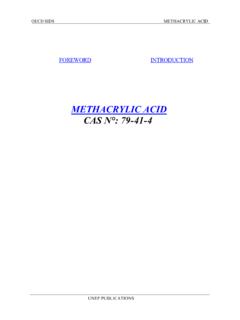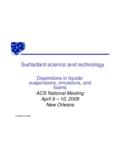Transcription of Eastman AAEM (acetoacetoxyethyl methacrylate)
1 Eastman AAEM (acetoacetoxyethyl methacrylate ) Acetoacetyl chemistryIUPAC: 2-[(2- methyl -1-oxo-2-propenyl)oxy]ethyl 3-oxobutanoateCAS: 021282-97-3CH3 OOOH2C = C C O CH2)2 O C CH2 C CH3(Key features Reduced solution viscosity Reduced polymer Tg Good acrylic reactivity Cross-linking versatility through multiple reaction pathways Improved adhesion through metal chelation Reactive pathways for further polymer modifi cationTable 1 Typical propertiesaMolecular weight (C10H14O5) , light yellow liquidAAEM, wt%972-Hydroxyethyl methacrylate , wt%2 Methacrylic acid, wt% glycol dimethacrylate, wt% , wt% (BHT), ppm300 Boiling pointPolymerizesSolubilityMiscible with most organic liquidsQ and e valuesHomopolymer ratiosMonomer 1 (M1)Monomer 2 (M2)
2 R1R2 Eastman AAEMM ethyl reported here are typical of average lots. Eastman makes no representation that the material in any particular shipment will conform exactly to the values AAEM finds use as an acrylic monomer for making polymers for coatings and adhesive applications. It is useful where increased nonvolatile content, cross-linking versatility particularly nonisocyanate room temperature cure or reduced glass transition temperatures are informationIn addition to its acrylic double bond, Eastman AAEM has two reactive sites located in the acetoacetoxy portion of the molecule: the active methylene group and the ketone carbonyl group. These two sites are useful for cross-linking or further modification of resins.
3 Having acetoacetyl Eastman AAEM (acetoacetoxyethyl methacrylate ) Acetoacetyl chemistry (Continued)Table 2 Resin composition and propertiesaAAEM/MMA copolymersMole % MMA1009080706040 Mole % Eastman AAEM01020304060Wt% Eastman , g/mol9,5858,8186,9677,6508,9309,396Mw, g/mol50,21515,69713,75022,02721,43718,76 8Tg, C1058457524432 Determined wt% viscosity, Pa s4712824224166aFormulations presented in this publication are starting points only. Customers must determine for themselves the formulation that best suits their particular : Vazo 67 catalyst (DuPont) Synthesis solvent: Ethyl 3-ethoxypropionate (EEP solvent)1 While Eastman AAEM does not contain hydroxyl groups, it is still capable of reaction with conventional melamine and isocyanate cross-linkers.
4 See Eastman publication N-322 for resin synthesis and propertiesSolution viscosityLower solution viscosity is the key to obtaining higher-solids coatings. The inclusion of Eastman AAEM in acrylic polymers adds a long, bulky pendant group to the polymer chain, giving increased separation between chains. The added separation and the fact that AAEM contains no hydroxyl functionality1 combine to minimize hydrogen groups pendant to a polymer chain also increases chain separation and free volume, thereby reducing polymer solution viscosity and glass transition steel 304SS and 316SS, as well as aluminum, are suitable materials for storage of Eastman AAEM. As with any reactive acrylate, store in a cool, dry area.
5 Precautions such as tank cooling and insulation to protect vessels from local heating are suggested for bulk storage. Replenish headspace air every 6 months with inert gas containing between 4% and 9% O2. Data from long-term storage stability tests are available on between polymer chains, leaving the polymer chains more mobile and decreasing solution viscosity. To illustrate the effect of AAEM on solution viscosity, a series of acrylic resins were prepared based on methyl methacrylate (MMA) with increasing amounts of AAEM. The resin composition, physical properties, and synthesis procedure are given in the following AAEM (acetoacetoxyethyl methacrylate ) Acetoacetyl chemistry (Continued)Resin synthesisReaction setup: Four-neck round-bottom flask equipped with (a) heating mantle, (b) air-driven stirrer, (c) nitrogen purge, (d) thermocouple and thermowatch electronic temperature control, (e) condenser, (f) addition procedure1.
6 Place Eastman EEP solvent in flask and heat to 100 Mix monomers and initiator to complete dissolution. Place mixture in an addition funnel and add dropwise to heated solvent over 4 to After addition of monomer mix is complete, let reaction continue at 100 C for Dropwise, add an additional mole % initiator as a 10 wt% solution in the Eastman EEP solvent over a 10 15 minute period to terminate the Turn heat off and transfer resin to storage viscosity data in Figure 1 illustrate the dramatic decrease in solution viscosity with increasing Eastman AAEM concentration. It should be noted that the major portion of the viscosity reduction occurs with the addition of the first 20 mole % of the 1 Effect of acetoacetyl groups on resin properties (Solution viscosity and Tg)Glass transition temperatureThe same increased chain separation and reduced hydrogen bonding characteristics of Eastman AAEM that give reduced solution viscosity also lead to lower glass transition temperature (Tg).
7 The Tg was measured for the series of model resins described in Table 2 using differential scanning calorimetry inflection point. The results, as seen in Figure 1, illustrate the reduction in Tg with even small amounts of AAEM. Lower Tgs are often equated to improved impact resistance in acrylic coatings reactivityThe reactivity of Eastman AAEM has been compared with an industry standard, methyl methacrylate (MMA), using a series of copolymers produced from monomer mixes prepared at 90/10, 80/20, 60/40, and 40/60 weight % ratios. Conversion was terminated at approximately 15%, and resin samples were analyzed for monomer content by nuclear magnetic 2 shows a plot of theoretical versus determined weight % AAEM in the copolymers.
8 An approximate 1:1 relationship exists between the theoretical and determined amounts of AAEM in the MMA copolymer, indicating that AAEM and MMA have similar degrees of reactivity in acrylic synthesis 2 Eastman AAEM reactivity110100908070605040302010100203 040 Solution viscosityMole % AAEMTg5060501001502002503003504004505000 0 Brookfield solution viscosity @ 60% inEastman EEP, Pa sTg, C6050403020 Theoretical weight % AAEM1000 Resin conversion stoppedat approx. 15%10203040506070 Determined weight % AAEM4 Acetoacetyl groups that are attached to a polymer can be used to modify or cross-link that polymer. This technology is receiving considerable attention from the plastics, coatings, and specialty polymers industries.
9 A brief overview of the chemistry of the acetoacetyl group is presented here with special emphasis on those reactions that can be used to modify acetoacetylated polymers can be prepared by polymerizing an acetoacetylated monomer such as Eastman AAEM into the polymer chain or by acetoacetylating a polymer after synthesis. Polymers such as hydroxylated polyesters can be acetoacetylated with Eastman t-BAA (t-butyl acetoacetate). There are two reactive sites on a polymer-anchored acetoacetyl group that can be used to form derivatives of the polymer: the active methylene group (CH2 and the ketone carbonyl group (C = O).MelaminesThe active methylene group will react with melamines under conditions similar to those required for the reaction of hydroxyls with melamines (Figure 3).)
10 The temperature required for reaction will depend on the choice of melamine. A fully methylated melamine requires a temperature of 150 C (300 F) plus an acid AAEM (acetoacetoxyethyl methacrylate ) Acetoacetyl chemistry (Continued)2 See Eastman publication N-328 for detailsFigure 3 Reaction with melamine at the active methylene groupCH3OO+C2 OPR(CHNH)H33CH3 POCCHCH2 NHRNHCH2 CHCOPCH3OH2+OOOOCC O C CH222 C CHP= polymer backboneacid==Note: Unlike the reaction of hydroxyl-functional resins with melamines, which forms an ether linkage, the reaction of the methylene group with melamines forms a carbon-carbon cross-linking pathways and reactions of acetoacetylated polymers5 Eastman AAEM (acetoacetoxyethyl methacrylate ) Acetoacetyl chemistry (Continued)IsocyanatesThe active methylene group will react with free isocyanates at ambient temperature and with blocked isocyanates at elevated temperature in a manner similar to the reaction of isocyanates with hydroxyls.


